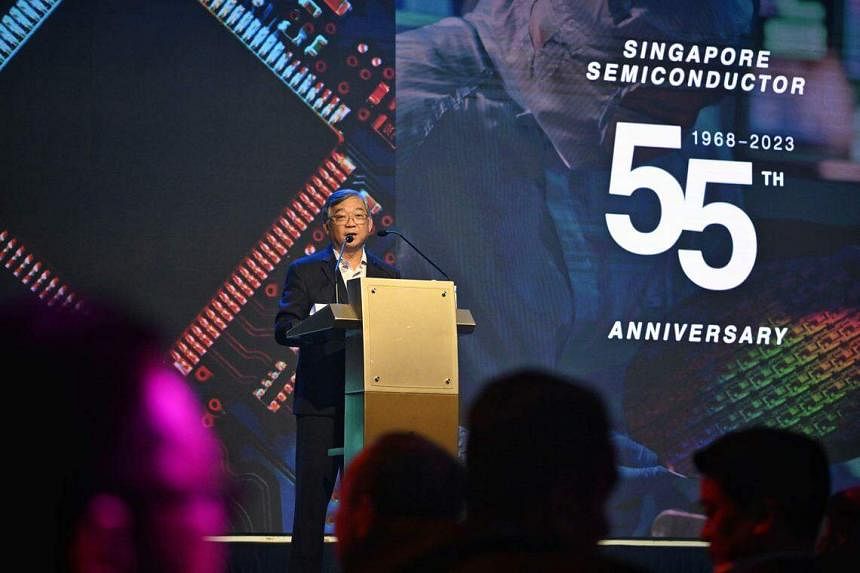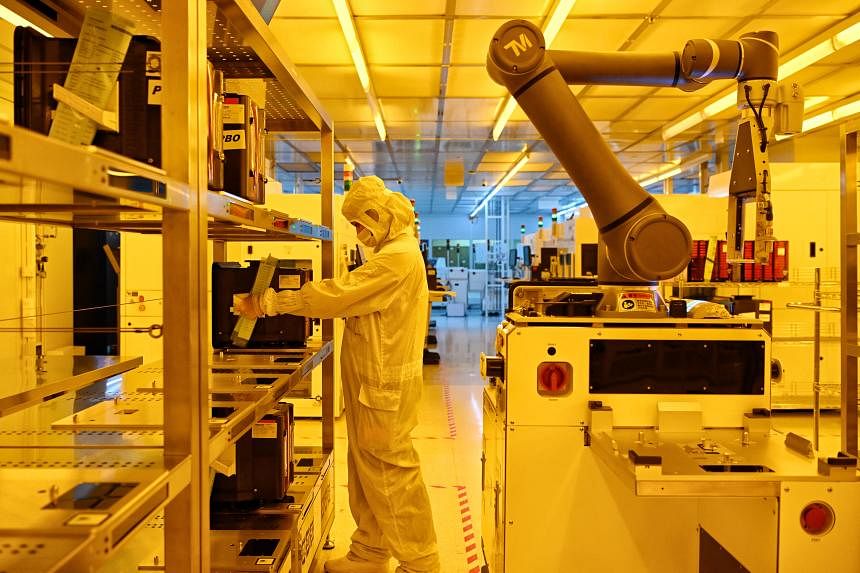SINGAPORE - A new six-month training programme for integrated circuit design will be launched in August 2024 to train up to 150 people over the next five years, said Trade and Industry Minister Gan Kim Yong on Tuesday.
The programme has been developed by the Singapore Semiconductor Industry Association (SSIA), Nanyang Technological University and the Economic Development Board (EDB) as part of an effort to provide more work-study training, immersion and internship opportunities, the minister said at an event to celebrate the 55th anniversary of the semiconductor industry in Singapore.
Mr Gan said EDB and SSIA will share more details of the training programme at a later date.
Integrated circuit designers in the United States earn an average of US$150,000 (S$204,000) annually before benefits, according to compensation tracker Salary.com.
Singapore will also double down on training research and development (R&D) talent to meet the target of producing 1,000 PhDs over the next 10 years, the minister added. Meanwhile, the Government will continue to collaborate with companies to provide scholarships and develop the postgraduate talent pool with critical R&D skills needed for the semiconductor industry, he said.
Mr Gan said Singapore will also continue to reskill its mid-career workers for new and enhanced roles in the semiconductor industry or redeployment into other good jobs within the sector. He said EDB will work with Workforce Singapore and the industry to achieve at least 1,300 placements for the electronics career-conversion programme over the next four years.
The minister said Singapore’s growing pool of talent is one of the key differentiators that have and will allow the Republic to attract investments in an industry that has become the focus of an intensifying global competition.
Countries around the world are rolling out massive subsidies to onshore and friend-shore investments closer to home, something Singapore cannot afford to match, he said, referring to incentives offered by some of the world’s largest economies, including the United States, China and the European Union.
“Thankfully for us, there remain opportunities for us to tap and grow the industry even in this climate,” he said. He noted that Singapore’s highly skilled workforce is backed by stable government, rule of law and extensive connectivity – factors that have enabled the industry to thrive here and develop a strong ecosystem. Hence, Singapore is well positioned to capture growth opportunities in the sector.
“We are seeing promising signs through the investments announced in the past year by semiconductor companies such as United Microelectronics Corporation, Siltronic and Silicon Box to expand their activities in Singapore.
“Just last week, GlobalFoundries held its grand opening of a $5 billion semiconductor fabrication plant, reflecting the continued confidence of the industry in Singapore,” Mr Gan said.
The semiconductor sector accounts for more than one-third of Singapore’s overall manufacturing value-add.
Mr Gan said that while the industry is experiencing a global slowdown, the demand for semiconductors will continue to grow, given the push in artificial intelligence, 5G and industrial Internet of Things (IoT).
He said Singapore views the transition to a low-carbon economy as another opportunity that companies here should leverage on.
“Singapore has committed to achieve net-zero emissions by 2050, and the transition to a low-carbon economy will be one of the most important transformations to our economy. Having a clear sustainability roadmap will be a competitive advantage for our companies.”
He stated that the Government will assist semiconductor companies here in adopting best-in-class technologies, such as efficient greenhouse-gas abatement systems and energy-efficient chilled water systems to achieve their net-zero goals.
Singapore has also announced plans to import up to 4 gigawatts of low-carbon electricity by 2035 to decarbonise the power sector, which will help companies here reduce their Scope 2 emissions – indirect greenhouse-gas emissions associated with the purchase of electricity, steam, heat or cooling.

Mr Ang Wee Seng, executive director of SSIA, said that over the past 55 years, Singapore has undergone a remarkable transformation, evolving from a labour-intensive assembly hub to an R&D base for cutting-edge technologies such as AI, photonics and micro-electromechanical systems.
“In today’s world of economic uncertainties and frequent supply-chain disruptions, the need for countries to collaborate collectively has never been more pressing. Disruptions in one part of the world can have a domino effect, compromising productivity and prompting delays in several countries and industries.
“Therefore, it is in everyone’s interest to work together, share knowledge and devise strategies that ensure the smooth running of this vital industry. Fostering global collaborations will fortify the semiconductor supply chain, boosting its resilience to adapt to the dynamic shifts in the global landscape for the future,” he said.


